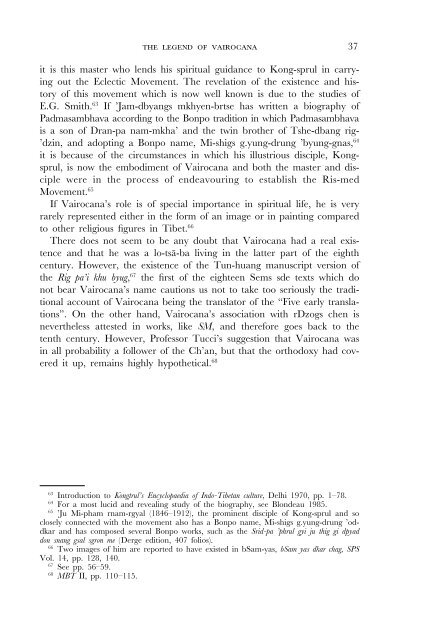Create successful ePaper yourself
Turn your PDF publications into a flip-book with our unique Google optimized e-Paper software.
the legend of vairocana 37<br />
it is this master who lends his spiritual guidance to Kong-sprul in carrying<br />
out the Eclectic Movement. The revelation of the existence and history<br />
of this movement which is now well known is due to the studies of<br />
E.G. Smith. 63 If ’Jam-dbyangs mkhyen-brtse has written a biography of<br />
Padmasambhava according to the Bonpo tradition in which Padmasambhava<br />
is a son of Dran-pa nam-mkha’ and the twin brother of Tshe-dbang rig-<br />
’dzin, and adopting a Bonpo name, Mi-shigs g.yung-drung ’byung-gnas, 64<br />
it is because of the circumstances in which his illustrious disciple, Kongsprul,<br />
is now the embodiment of Vairocana and both the master and disciple<br />
were in the process of endeavouring to establish the Ris-med<br />
Movement. 65<br />
If Vairocana’s role is of special importance in spiritual life, he is very<br />
rarely represented either in the form of an image or in painting compared<br />
to other religious figures in Tibet. 66<br />
There does not seem to be any doubt that Vairocana had a real existence<br />
and that he was a lo-tsà-ba living in the latter part of the eighth<br />
century. However, the existence of the Tun-huang manuscript version of<br />
the Rig pa’i khu byug, 67 the first of the eighteen Sems sde texts which do<br />
not bear Vairocana’s name cautions us not to take too seriously the traditional<br />
account of Vairocana being the translator of the “Five early translations”.<br />
On the other hand, Vairocana’s association with rDzogs chen is<br />
nevertheless attested in works, like SM, and therefore goes back to the<br />
tenth century. However, Professor Tucci’s suggestion that Vairocana was<br />
in all probability a follower of the Ch’an, but that the orthodoxy had covered<br />
it up, remains highly hypothetical. 68<br />
63 Introduction to Kongtrul’s Encyclopaedia of Indo-Tibetan culture, Delhi 1970, pp. 1–78.<br />
64 For a most lucid and revealing study of the biography, see Blondeau 1985.<br />
65 ’Ju Mi-pham rnam-rgyal (1846–1912), the prominent disciple of Kong-sprul and so<br />
closely connected with the movement also has a Bonpo name, Mi-shigs g.yung-drung ’oddkar<br />
and has composed several Bonpo works, such as the Srid-pa ’phrul gyi ju thig gi dpyad<br />
don snang gsal sgron me (Derge edition, 407 folios).<br />
66 Two images of him are reported to have existed in bSam-yas, bSam yas dkar chag, SPS<br />
Vol. 14, pp. 128, 140.<br />
67 See pp. 56–59.<br />
68 MBT II, pp. 110–115.

















